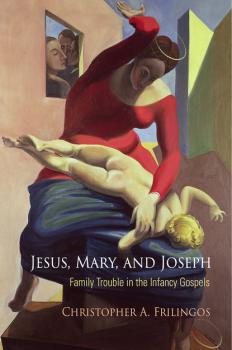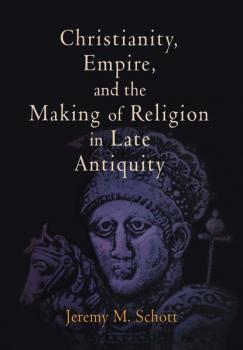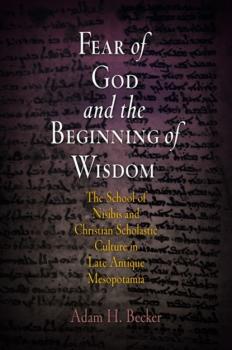Divinations: Rereading Late Ancient Religion
Скачать книги из серии Divinations: Rereading Late Ancient ReligionAncient Christian Ecopoetics
In our age of ecological crisis, what insights—if any—can we expect to find by looking to our past? Perhaps, suggests Virginia Burrus, early Christianity might yield usable insights. Turning aside from the familiar specter of Christianity's human-centered theology of dominion, Burrus directs our attention to aspects of ancient Christian thought and practice that remain strange and alien. Drawn to excess and transgression, in search of transformation, early Christians creatively reimagined the universe and the human, cultivating relationships with a wide range of other beings—animal, vegetable, and mineral; angelic and demonic; divine and earthly; large and small. In Ancient Christian Ecopoetics , Burrus facilitates a provocative encounter between early Christian theology and contemporary ecological thought. In the first section, she explores how the mysterious figure of khora , drawn from Plato's Timaeus , haunts Christian and Jewish accounts of a creation envisioned as varyingly monstrous, unstable, and unknowable. In the second section, she explores how hagiographical literature queers notions of nature and places the very category of the human into question, in part by foregrounding the saint's animality, in part by writing the saint into the landscape. The third section considers material objects, as small as portable relics and icons, as large as church and monastery complexes. Ancient Christians considered all of these animate beings, simultaneously powerful and vulnerable, protective and in need of protection, lovable and loving. Viewed through the shifting lenses of an ancient ecopoetics, Burrus demonstrates how humans both loomed large and shrank to invisibility, absorbed in the rapture of a strange and animate ecology.
Jesus, Mary, and Joseph
When Jesus was five he killed a boy, or so reports the Infancy Gospel of Thomas . A little boy had run into Jesus by accident, bumping him on the shoulder, and Jesus took offense: «Jesus was angry and said to him, 'You shall go no further on your way,' and instantly the boy fell down and died.» A second story recounts how Jesus transformed mud into living birds, while yet another has Joseph telling Mary to keep Jesus in the house so that no one else gets hurt. What was life really like in the household of Joseph, Mary, and little Jesus? The canon of the New Testament provides few details, but ancient Christians, wanting to know more, would turn to the texts we know as the «Infancy Gospels.» The Infancy Gospel of Thomas is a collection of stories from the mid-second century C.E. describing events in the life of Jesus between the ages of five and twelve. The Proto-gospel of James , also dating from the second century, focuses on Mary and likewise includes episodes from her childhood. These gospels are often cast aside as marginal character sketches, designed to assure the faithful that signs of divine grace cropped up in the early years of both Mary and Jesus. Christopher A. Frilingos contends instead that the accounts are best viewed as meditations on family. Both gospels offer rich portrayals of household relationships at a time when ancient Christians were locked in a fierce debate about family—not only on the question of what a Christian family ought to look like but also on whether Christians should pursue family life at all. Describing the conflicts of family life, the gospels present Jesus, Mary, and Joseph in moments of weakness and strength, reminding early Christians of the canyon separating human ignorance and divine knowledge. According to Frilingos, the depicted acts of love and courage performed in the face of great uncertainty taught early Christian readers the worth of human relationships.
Zayd
Although Muḥammad had no natural sons who reached the age of maturity, Islamic sources report that he adopted a man named Zayd shortly before receiving his first revelation. This «son of Muḥammad» was the Prophet's heir for the next fifteen or twenty years. He was the first adult male to become a Muslim and the only Muslim apart from Muḥammad whose name is mentioned in the Qur'an. Eventually, Muḥammad would repudiate Zayd as his son, abolish the institution of adoption, and send Zayd to certain death on a battlefield in southern Jordan. Curiously, Zayd has remained a marginal figure in both Islamic and Western scholarship. David S. Powers now attempts to restore Zayd to his rightful position at the center of the narrative of the Prophet Muḥammad and the beginnings of Islam. To do so, he mines traces left behind in commentaries on the Qur'an, in biographical dictionaries, and in historical chronicles, reading these sources against analogues in the Hebrew Bible. Powers demonstrates that in the accounts preserved in these sources, Zayd's character is modeled on those of biblical figures such as Isaac, Ishmael, Joseph, and Uriah the Hittite. This modeling process was deployed by early Muslim storytellers to address two key issues, Powers contends: the bitter conflict over succession to Muḥammad and the key theological doctrine of the finality of prophecy. Both Zayd's death on a battlefield and Muḥammad's repudiation of his adopted son and heir were after-the-fact constructions driven by political and theological imperatives.
Thorns in the Flesh
The literature of late ancient Christianity is rich both in saints who lead lives of almost Edenic health and in saints who court and endure horrifying diseases. In such narratives, health and illness might signify the sanctity of the ascetic, or invite consideration of a broader theology of illness. In Thorns in the Flesh , Andrew Crislip draws on a wide range of texts from the fourth through sixth centuries that reflect persistent and contentious attempts to make sense of the illness of the ostensibly holy. These sources include Lives of Antony, Paul, Pachomius, and others; theological treatises by Basil of Caesarea and Evagrius of Pontus; and collections of correspondence from the period such as the Letters of Barsanuphius and John. Through close readings of these texts, Crislip shows how late ancient Christians complicated and critiqued hagiographical commonplaces and radically reinterpreted illness as a valuable mode for spiritual and ascetic practice. Illness need not point to sin or failure, he demonstrates, but might serve in itself as a potent form of spiritual practice that surpasses even the most strenuous of ascetic labors and opens up the sufferer to a more direct knowledge of the self and the divine. Crislip provides a fresh and nuanced look at the contentious and dynamic theology of illness that emerged in and around the ascetic and monastic cultures of the later Roman world.
Christianity, Empire, and the Making of Religion in Late Antiquity
In Christianity, Empire, and the Making of Religion in Late Antiquity , Jeremy M. Schott examines the ways in which conflicts between Christian and pagan intellectuals over religious, ethnic, and cultural identity contributed to the transformation of Roman imperial rhetoric and ideology in the early fourth century C.E. During this turbulent period, which began with Diocletian's persecution of the Christians and ended with Constantine's assumption of sole rule and the consolidation of a new Christian empire, Christian apologists and anti-Christian polemicists launched a number of literary salvos in a battle for the minds and souls of the empire. Schott focuses on the works of the Platonist philosopher and anti- Christian polemicist Porphyry of Tyre and his Christian respondents: the Latin rhetorician Lactantius, Eusebius, bishop of Caesarea, and the emperor Constantine. Previous scholarship has tended to narrate the Christianization of the empire in terms of a new religion's penetration and conquest of classical culture and society. The present work, in contrast, seeks to suspend the static, essentializing conceptualizations of religious identity that lie behind many studies of social and political change in late antiquity in order to investigate the processes through which Christian and pagan identities were constructed. Drawing on the insights of postcolonial discourse analysis, Schott argues that the production of Christian identity and, in turn, the construction of a Christian imperial discourse were intimately and inseparably linked to the broader politics of Roman imperialism.
Grammar and Christianity in the Late Roman World
Between the years 350 and 500 a large body of Latin artes grammaticae emerged, educational texts outlining the study of Latin grammar and attempting a systematic discussion of correct Latin usage. These texts—the most complete of which are attributed to Donatus, Charisius, Servius, Diomedes, Pompeius, and Priscian—have long been studied as documents in the history of linguistic theory and literary scholarship. In Grammar and Christianity in the Late Roman World , Catherine Chin instead finds within them an opportunity to probe the connections between religious ideology and literary culture in the later Roman Empire. To Chin, the production and use of these texts played a decisive role both in the construction of a pre-Christian classical culture and in the construction of Christianity as a religious entity bound to a religious text. In exploring themes of utopian writing, pedagogical violence, and the narration of the self, the book describes the multiple ways literary education contributed to the idea that the Roman Empire and its inhabitants were capable of converting from one culture to another, from classical to Christian. The study thus reexamines the tensions between these two idealized cultures in antiquity by suggesting that, on a literary level, they were produced simultaneously through reading and writing techniques that were common across the empire. In bringing together and reevaluating fundamental topics from the fields of religious studies, classics, education, and literary criticism, Grammar and Christianity in the Late Roman World offers readers from these disciplines the opportunity to reconsider the basic conditions under which religions and cultures interact.
Saving Shame
Virginia Burrus explores one of the strongest and most disturbing aspects of the Christian tradition, its excessive preoccupation with shame. While Christianity has frequently been implicated in the conversion of ancient Mediterranean cultures from shame- to guilt-based and, thus, in the emergence of the modern West's emphasis on guilt, Burrus seeks to recuperate the importance of shame for Christian culture. Focusing on late antiquity, she explores a range of fascinating phenomena, from the flamboyant performances of martyrs to the imagined abjection of Christ, from the self-humiliating disciplines of ascetics to the intimate disclosures of Augustine. Burrus argues that Christianity innovated less by replacing shame with guilt than by embracing shame. Indeed, the ancient Christians sacrificed honor but laid claim to their own shame with great energy, at once intensifying and transforming it. Public spectacles of martyrdom became the most visible means through which vulnerability to shame was converted into a defiant witness of identity; this was also where the sacrificial death of the self exemplified by Christ's crucifixion was most explicitly appropriated by his followers. Shame showed a more private face as well, as Burrus demonstrates. The ambivalent lure of fleshly corruptibility was explored in the theological imaginary of incarnational Christology. It was further embodied in the transgressive disciplines of saints who plumbed the depths of humiliation. Eventually, with the advent of literary and monastic confessional practices, the shame of sin's inexhaustibility made itself heard in the revelations of testimonial discourse. In conversation with an eclectic constellation of theorists, Burrus interweaves her historical argument with theological, psychological, and ethical reflections. She proposes, finally, that early Christian texts may have much to teach us about the secrets of shame that lie at the heart of our capacity for humility, courage, and transformative love.
Fear of God and the Beginning of Wisdom
The School of Nisibis was the main intellectual center of the Church of the East in the sixth and early seventh centuries C.E. and an institution of learning unprecedented in antiquity. Fear of God and the Beginning of Wisdom provides a history both of the School and of the scholastic culture of the Church of the East more generally in the late antique and early Islamic periods. Adam H. Becker examines the ideological and intellectual backgrounds of the school movement and reassesses the evidence for the supposed predecessor of the School of Nisibis, the famed School of the Persians of Edessa. Furthermore, he argues that the East-Syrian («Nestorian») school movement is better understood as an integral and at times contested part of the broader spectrum of East-Syrian monasticism. Becker examines the East-Syrian culture of ritualized learning, which flourished at the same time and in the same place as the famed Babylonian Rabbinic academies. Jews and Christians in Mesopotamia developed similar institutions aimed at inculcating an identity in young males that defined them as beings endowed by their creator with the capacity to study. The East-Syrian schools are the most significant contemporary intellectual institutions immediately comparable to the Rabbinic academies, even as they served as the conduit for the transmission of Greek philosophical texts and ideas to Muslims in the early 'Abbasid period.
The Sex Lives of Saints
Has a repressive morality been the primary contribution of Christianity to the history of sexuality? The ascetic concerns that pervade ancient Christian texts would seem to support such a common assumption. Focusing on hagiographical literature, Virginia Burrus pursues a fresh path of interpretation, arguing that the early accounts of the lives of saints are not antierotic but rather convey a sublimely transgressive «countereroticism» that resists the marital, procreative ethic of sexuality found in other strands of Christian tradition. Without reducing the erotics of ancient hagiography to a single formula, The Sex Lives of Saints frames the broad historical, theological, and theoretical issues at stake in such a revisionist interpretation of ascetic eroticism, with particular reference to the work of Michel Foucault and Georges Bataille, David Halperin and Geoffrey Harpham, Leo Bersani and Jean Baudrillard. Burrus subsequently proceeds through close, performative readings of the earliest Lives of Saints, mostly dating to the late fourth and early fifth centuries—Jerome's Lives of Paul, Malchus, Hilarion, and Paula; Gregory of Nyssa's Life of Macrina; Augustine's portrait of Monica; Sulpicius Severus's Life of Martin; and the slightly later Lives of so-called harlot saints. Queer, s/m, and postcolonial theories are among the contemporary discourses that prove intriguingly resonant with an ancient art of «saintly» loving that remains, in Burrus's reading, promisingly mobile, diverse, and open-ended.









